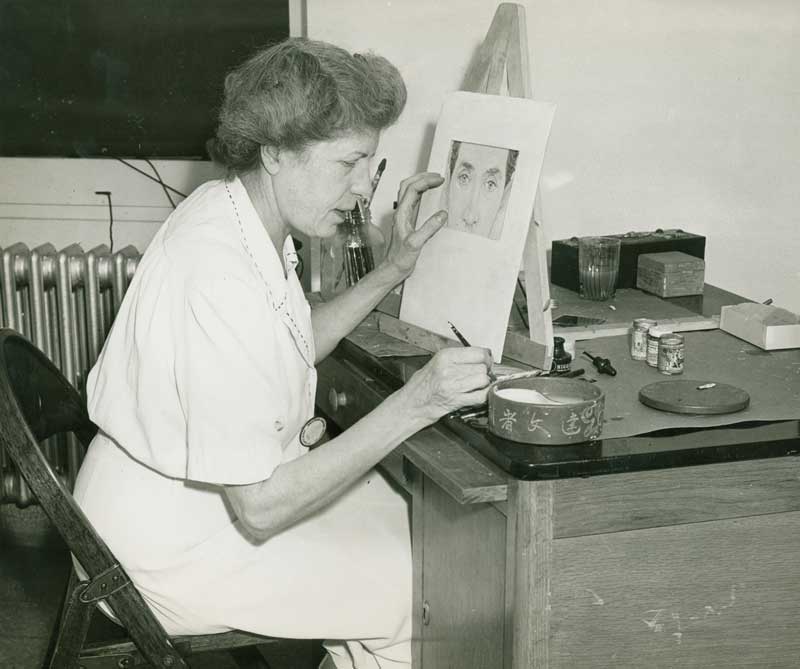 Mildred Burrage worked as a medical artist at the U.S. Army's Halloran Hospital on Staten Island, New York, in 1944. Collections of Maine Historical Society, 53955
Mildred Burrage worked as a medical artist at the U.S. Army's Halloran Hospital on Staten Island, New York, in 1944. Collections of Maine Historical Society, 53955
Mildred Giddings Burrage was one of Maine’s most creative 20th century artists, who, among many accomplishments, put her considerable talents to work on behalf of the United States’ ship-building efforts during World War II.
Born in Portland in 1890 and living until 1983, Burrage spent most of her life between 1909 and 1914 in France learning to paint in the American Impressionistic style. Based in Giverny, she received instruction there from the American artist Richard Miller and in Paris art schools. She also painted in Brittany as well as in Rome and Venice. During this period, she met such luminaries as artist Claude Monet, writer Gertrude Stein, poet Harriet Monroe, and suffragette Emmeline Pankhurst.
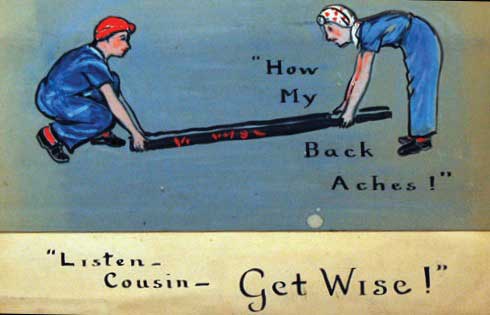 Mildred Burrage worked as a medical artist at the U.S. Army's Halloran Hospital on Staten Island, New York, in 1944. Portland Museum of Art, 1981.413
Mildred Burrage worked as a medical artist at the U.S. Army's Halloran Hospital on Staten Island, New York, in 1944. Portland Museum of Art, 1981.413
At the outbreak of World War I in 1914, Burrage returned to her family’s home in Portland. One year later, the Burrages moved to Kennebunkport, where the family became involved with war-related Red Cross efforts, and where Mildred pursued her artistic career for the next 25 years. Living in this beautiful coastal Maine village afforded her close friendships with two of its most prominent residents, authors Booth Tarkington and Kenneth Roberts.
During the 1920s she specialized in painting portraits and recreating historical maps. In the 1930s she and her sister, Madeleine, traveled to Nevada, Arizona, New Mexico, Mexico, and Guatemala. During her travels, she painted realistic scenes of Virginia City, the Southwestern desert, and Latin American culture. At the same time, Madeleine made finely crafted gold and silver jewelry that featured semi-precious stones.
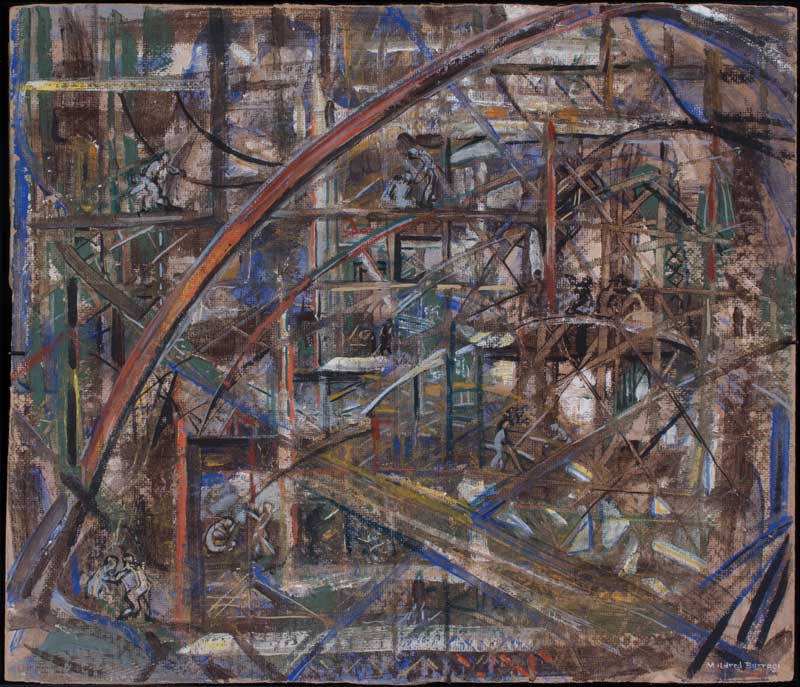 Burrage’s painting portrays the scaffolding for building a Liberty Ship at the South Portland Shipyard during World War II. Portland Museum of Art, 1981.142. Photo by Jay York.
Burrage’s painting portrays the scaffolding for building a Liberty Ship at the South Portland Shipyard during World War II. Portland Museum of Art, 1981.142. Photo by Jay York.
Recalling their family’s commitment to the American Red Cross in World War I, the Burrage sisters resumed their participation in the Kennebunkport chapter as World War II began. Mildred chaired the group’s volunteer services as well as its salvage drive. She expressed her support for the war effort in a letter to the Portland Press Herald that ended with , “The only way to preserve democracy is to fight for it—as a volunteer.”
During the second World War, Maine served as a major shipbuilding center. While submarines were constructed in Kittery and destroyers in Bath, the South Portland yard of the New England Shipbuilding Corp. launched 239 Liberty Ships to carry weapons and supplies to the battlefronts of Europe. To produce this armada of transport vessels, large numbers of women entered the workplace to fill the jobs of men serving in the armed forces. At the age of 52 in 1942, Mildred Burrage became one of those women by joining the staff of the South Portland yard to provide instruction about the occupational hazards of shipbuilding. Of this experience, she wrote, “I worked as a counselor to women in the South Portland yard. I soon realized that art was needed there, too, and I obtained permission to do protective and helpful posters for the women at work.”
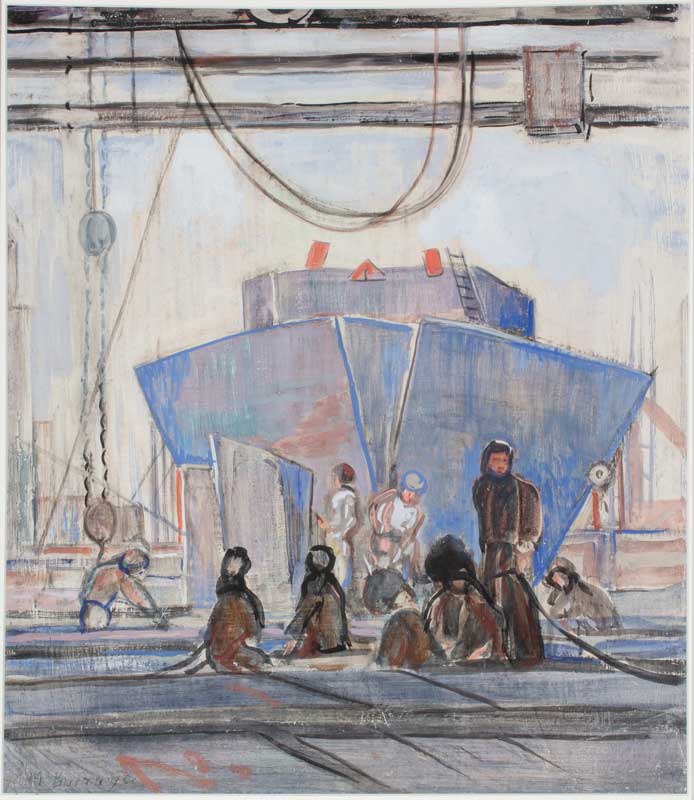 Building a Liberty Ship, South Portland Shipyard, by Mildred Burrage, circa 1942-43. Collections of Maine Historical Society, 2010.406.003 (detail)
Building a Liberty Ship, South Portland Shipyard, by Mildred Burrage, circa 1942-43. Collections of Maine Historical Society, 2010.406.003 (detail)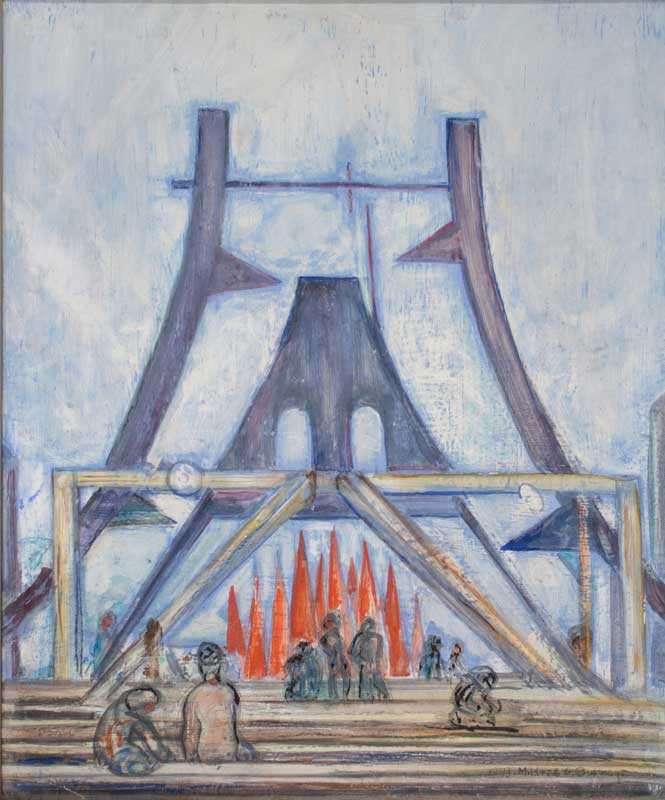 Laying the keel of a Liberty Ship, South Portland shipyard, by Mildred Burrage, circa 1942-43. Collections of Maine Historical Society, 2019.333 (detail)
Laying the keel of a Liberty Ship, South Portland shipyard, by Mildred Burrage, circa 1942-43. Collections of Maine Historical Society, 2019.333 (detail)
Burrage’s efforts proved a great success. In its Oct. 1, 1943, issue, The Art Digest reported, “Miss Burrage has just completed a series of safety posters showing the proper dress for women workers. The first artist to be employed by a rather cautious maritime commission, Miss Burrage has since been acclaimed by management and workers alike—the women protesting when the posters were taken down to be changed and management satisfied that in her drawings it had found the solution to dangling jewelry and glamourous hairdos.”
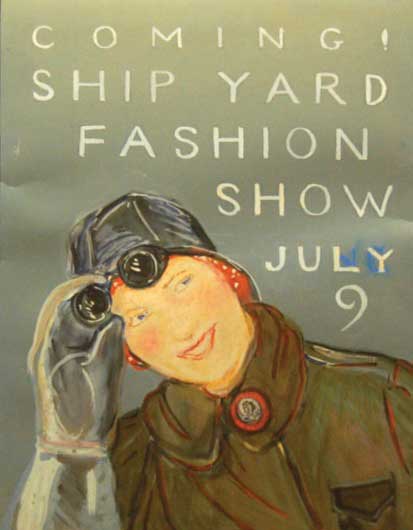 This Mildred Burrage poster advertises a shipyard fashion show for women workers in 1943. Portland Museum of Art, 1981.1322.32During her two years in South Portland, Burrage also made several sketches and drawings of women workers. One example is her charcoal portrait of Hazel Wildes of Kennebunkport in her work clothes. This sympathetic portrayal of a young female shipbuilder celebrates Wildes’s contributions to the war effort in its accompanying inscription listing her activities. The picture speaks to the dignity and value of labor in the cause of one’s country.
This Mildred Burrage poster advertises a shipyard fashion show for women workers in 1943. Portland Museum of Art, 1981.1322.32During her two years in South Portland, Burrage also made several sketches and drawings of women workers. One example is her charcoal portrait of Hazel Wildes of Kennebunkport in her work clothes. This sympathetic portrayal of a young female shipbuilder celebrates Wildes’s contributions to the war effort in its accompanying inscription listing her activities. The picture speaks to the dignity and value of labor in the cause of one’s country.
Burrage also depicted the making of Liberty Ships. Two striking watercolor-on-gesso pictures show the laying of a keel and the building of a vessel. The strength and force of steel construction is evident in both these paintings, conveyed by simple forms and strong colors. Added to these pictures is a remarkable watercolor-on-gesso painting of the intricate labyrinth of scaffolding required to build a ship. Reminiscent of a Piranesi etching of a surreal imaginary prison interior, this complex image foreshadows the abstraction of Burrage’s post World War II mica paintings.
Early in 1944, the Burrage sisters left Kennebunkport for a new assignment at the U.S. Army’s Halloran Hospital on Staten Island, New York, which cared for wounded soldiers requiring reconstructive treatment. There, Mildred and Madeleine volunteered their services as instructors in the hospital’s Arts and Skills Unit, which was sponsored by the New York Chapter of the American Red Cross, in cooperation with the Metropolitan Museum of Art. This recreational therapy program was designed to help patients to recover through drawing, painting, and a wide range of crafts. In the August 1944 issue of Craft Horizons, Mildred Burrage wrote in an article entitled, “Craftsmen Can Help” that “the success of the program has been so marked, the men enjoy it so much, that the Army and Navy hospitals all over the country want Recreational Therapy.”
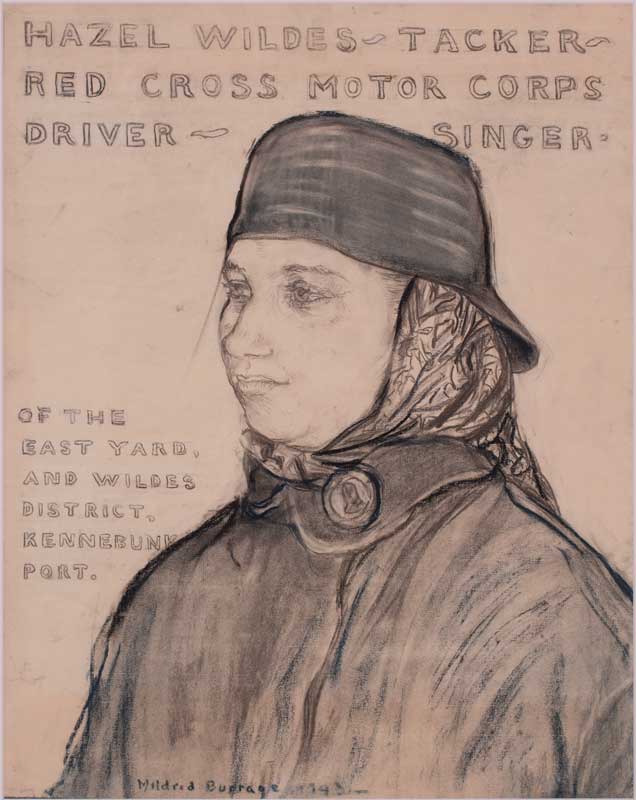 A charcoal portrait of Hazel Wildes of Kennebunkport, drawn during World War II, shows her in work clothes for her job at the South Portland Shipyard. Portland Museum of Art, 1981.412. Photo by Jay York.
A charcoal portrait of Hazel Wildes of Kennebunkport, drawn during World War II, shows her in work clothes for her job at the South Portland Shipyard. Portland Museum of Art, 1981.412. Photo by Jay York.
While at the Halloran Hospital in 1944 and 1945, Mildred Burrage also served as a medical artist. In this role, she made detailed watercolor studies of soldiers’ faces, documenting eye replacements and skin reconstruction. Twenty-one of these medical portraits are in the Otis Historical Archives’ Medical Illustration Collection at the National Museum of Health and Medicine.
When World War II ended, the Burrages returned to Kennebunkport, secure in Mildred’s belief that they had “helped put our fighting men back on the path to strength and health.”
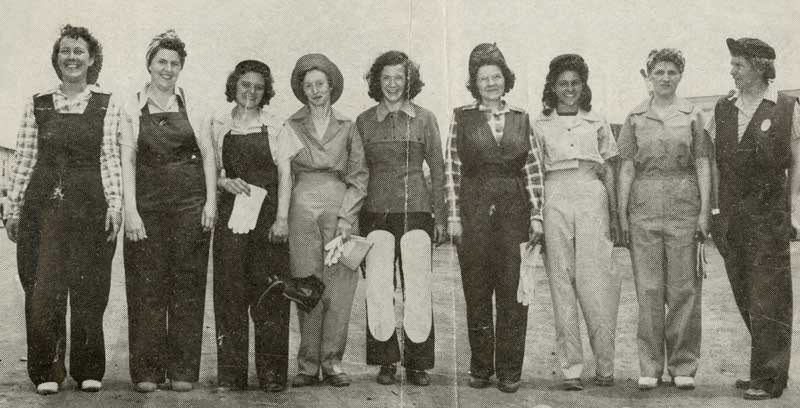 Mildred Burrage, at the far right, poses with participants in a fashion show of work clothes she organized at the South Portland shipyard in 1943. The theme of the show was “What the Well-Dressed Woman War Worker Wears.” Collections of Maine Historical Society, 111091
Mildred Burrage, at the far right, poses with participants in a fashion show of work clothes she organized at the South Portland shipyard in 1943. The theme of the show was “What the Well-Dressed Woman War Worker Wears.” Collections of Maine Historical Society, 111091
The sisters were about to embark on a new path that would take them to Wiscasset in 1946. There Mildred began to paint abstract mica collages. Inspired by Jackson Pollack, these distinctive modern pictures became the focus of her work until she stopped painting in 1980 at the age of 90. In addition to her artistic achievements, Burrage is remembered as a tireless advocate for advancing the cultural life of Maine through art, history, and historic preservation.
✮
Earle G. Shettleworth Jr. directed the Maine Historic Preservation Commission from 1976 to 2015, and he has served as Maine State Historian since 2004.






